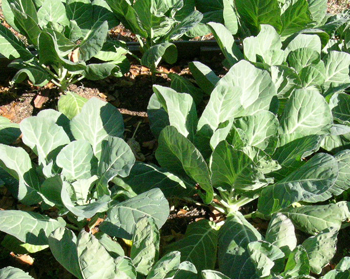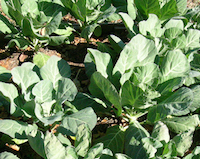Add this to the list of things that Georgians already knew. Collards are good for us, and go with just about anything.
More and more chefs across the country are choosing Georgia’s beloved collards on fine-dining menus and are using the time-tested green in new ways. This new collard boom could help Georgia farmers realize more green for their greens in the coming months.
Traditional preparation involves cooking the leaves down until they are tender, often with a ham hock to add flavor. But today, collards are being cooked more gently, used as wrappers for everything from sushi to burritos, baked into chips and shredded and pickled into a tongue-tingling slaw.
"Collards have a versatility beyond the long, slow-cooked method traditionally utilized in the South,” said Chef Hugh Acheson, chef-owner of Five and Ten in Athens, Georgia, and author of the James Beard Foundation Award-winning cookbook, “A New Turn in the South.”
“As we've broadened our culinary techniques and our ability to make something as tough and fibrous as collard greens tender and tasty, we've seen a good bit of growth and new trends with the vegetable.”
There’s just something about the collard that makes people think about comfort food and homemade meals. It allows chefs to play with techniques that might be a little out of the ordinary, added Peter Dale, chef and partner at Athens, Georgia’s The National and three other restaurants in the state.
“Southern food has become America's comfort food and, as a result, traditionally Southern ingredients like collard greens are now enjoyed throughout the country,” Dale said.
It’s not just that collards make us feel happy and safe, they also can make us healthier.
Collards have a higher nutrient density than kale, and are an excellent source of vitamin A, vitamin K and vitamin C. When steamed, collard greens have the ability to lower cholesterol better than any other leafy green.
The buzz surrounding collard greens is sure to be good for Georgia’s farmers. Georgia is the second-largest grower of collard greens, and is the No. 1 supplier for the Southeast and parts of the Midwest. In 2013, greens of some type covered 13,000 acres of the state and were worth about $60 million, according to the 2013 Georgia Farm Gate Value Report, published by the University of Georgia Center for Agribusiness and Economic Development.
If demand drives up prices, Georgia’s farmers will be ready to take advantage of the spike, said Tim Coolong, vegetable production horticulturist with UGA Extension.
“Georgia has a good climate for production of collards during much of the year,” Coolong said. “Though leafy green production slows during the hottest parts of the year, collards are grown and harvested from the early fall through winter and into late spring in most parts of south Georgia, with some growers supplying product year-round.”
When an area has produced greens for many years there tends to be a build-up of pest pressure to be dealt with, but Georgia’s farmers have always found a way to manage insect and disease pests and to produce a high quality product that is sold all over the U.S., according to Coolong.
Around 2012 the demand for kale jumped, and seemingly overnight, growers and seed producers were bombarded with a demand for the leafy green. Just a few years ago, Pizza Hut was the largest purchaser of kale, and that was solely to decorate their salad bar.
“The growth in kale took many by surprise, and we are still catching up,” Coolong said. “All of a sudden, everyone wanted kale; some people in the industry had to rush to keep up with demand.”
In contrast to the sudden popularity of kale, farmers in Georgia have always produced collards and several varieties have been developed to thrive in the state’s soil and climate.
“We have good growing conditions for all but about one or two months a year,” he said. “So we can supply greens to the market more or less year-round.”
As the rest of the country begins to pay more attention to the collard, Georgia farmers can expect to see an increase in demand for this crop and increased profits to boot.
For more information on how to grow collards in Georgia, search extension.uga.edu/publications.








